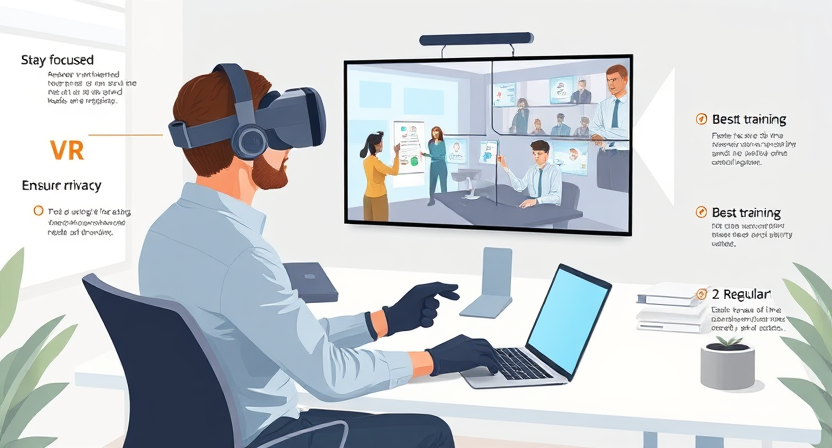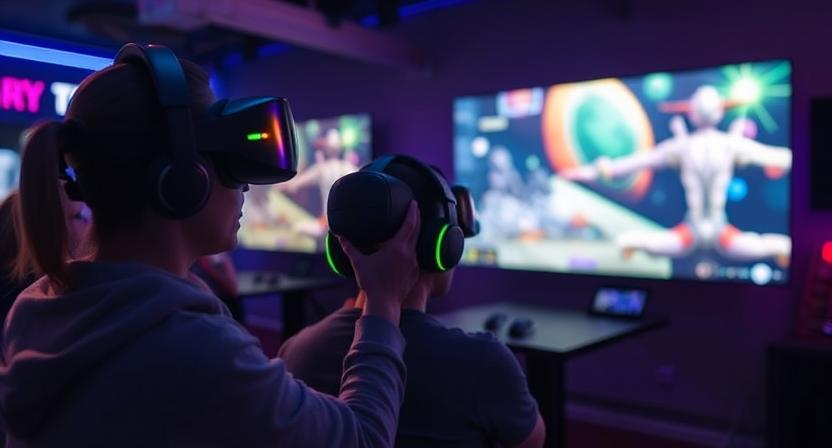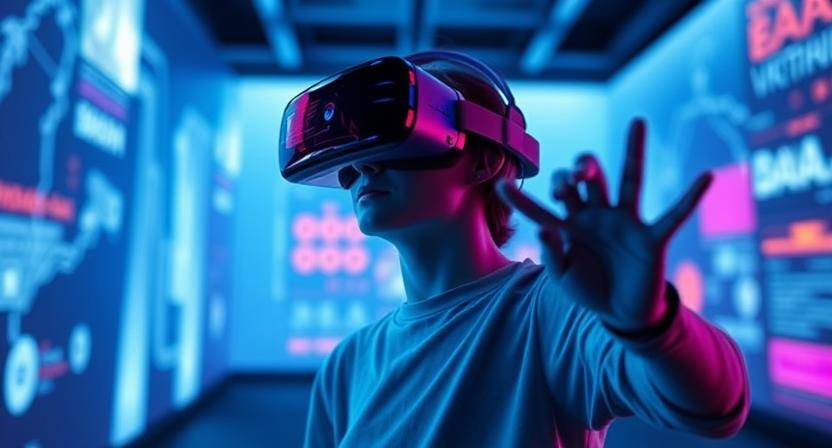The Benefits of Virtual Reality for Remote Work

Virtual reality (VR) technologies offer remote workers a myriad of benefits that can significantly enhance their productivity and overall work experience. One of the key advantages of VR in remote work settings is the ability to create an immersive virtual workspace that simulates a traditional office environment. This not only helps in reducing feelings of isolation and loneliness but also fosters a sense of presence and connectedness among team members spread across different locations.
Moreover, by leveraging VR tools, remote workers can engage in virtual meetings, collaborations, and trainings as if they were physically present in the same room. This level of interaction and immersion can lead to more effective communication, improved team dynamics, and enhanced problem-solving capabilities. Additionally, VR can offer unique opportunities for remote workers to access specialized training programs, attend virtual conferences, and participate in virtual team-building activities, all of which contribute to a more engaging and fulfilling remote work experience.
Understanding the Different VR Tools Available for Remote Work

Virtual reality (VR) tools offer a range of options for remote work environments, providing unique opportunities for collaboration, communication, and productivity. Among the various tools available, VR headsets stand out as a popular choice for immersing remote workers in virtual environments that mimic physical office spaces. These headsets enable employees to attend meetings, interact with colleagues, and engage in virtual team-building activities as if they were all in the same room, fostering a sense of presence and connectivity despite physical distances.
In addition to VR headsets, tools like VR whiteboards and spatial collaboration platforms are gaining traction in remote work settings. VR whiteboards allow team members to brainstorm, ideate, and visualize concepts together in a shared virtual space, enhancing creativity and fostering innovative thinking. Spatial collaboration platforms enable remote teams to work together in a three-dimensional environment, facilitating real-time interactions and seamless communication, ultimately improving the overall efficiency and effectiveness of remote collaborations.
How VR Can Improve Collaboration Among Remote Teams

Virtual reality (VR) technology is revolutionizing the way remote teams collaborate by offering immersive and interactive experiences that bridge the physical distance between team members. By creating lifelike virtual environments, VR enables team members to feel as though they are working together in the same room, despite being thousands of miles apart. This heightened sense of presence fosters better communication and deeper connections among team members, enhancing collaboration and productivity.
In addition to breaking down geographical barriers, VR tools provide remote teams with unique opportunities to engage in collaborative activities in ways that were previously constrained by traditional remote work setups. Through shared virtual spaces, team members can brainstorm ideas, create prototypes, and solve problems together in real time, fostering a sense of teamwork and camaraderie that is essential for successful collaboration. By leveraging the power of VR technology, remote teams can overcome the challenges of distance and time zones to work together seamlessly towards common goals.
Best Practices for Implementing VR in Remote Work Environments

When implementing virtual reality (VR) in remote work environments, it is essential to start with proper training for all team members. This training should cover not only how to use the VR tools effectively but also emphasize the importance of data security and privacy protocols. Providing comprehensive training upfront can help to prevent issues and ensure that all employees are using the technology safely and efficiently.
Another best practice for implementing VR in remote work environments is to establish clear communication channels for troubleshooting and support. It is crucial to have designated points of contact or resources available to address any technical issues or questions that may arise while using VR. By creating a support system that is easily accessible, remote teams can stay productive and avoid prolonged downtimes due to technical difficulties.
Tips for Enhancing Productivity Using VR in Remote Work

When utilizing virtual reality (VR) in remote work environments to boost productivity, it is essential to create a dedicated and distraction-free workspace for VR activities. By designating a specific area for VR work, employees can minimize interruptions and focus on their tasks more effectively. Additionally, ensuring that the VR equipment is set up correctly and is in good working condition can prevent technical issues that could hinder productivity.
Another tip for enhancing productivity with VR in remote work is to establish clear goals and objectives for each VR session. By outlining what needs to be accomplished and how VR will be used to achieve those goals, employees can stay on track and make the most of their virtual experiences. Setting milestones and deadlines within VR projects can provide a sense of direction and motivation for remote teams, ultimately leading to improved productivity outcomes.
Overcoming Challenges When Using VR for Remote Work

One common challenge when using VR for remote work is ensuring that all team members have access to the necessary equipment and technology. Not everyone may have a VR headset or the required software, which can create disparities in participation and collaboration. Overcoming this challenge involves providing adequate resources and support for all team members to ensure equal opportunities for engagement in virtual reality experiences.
Additionally, technical issues such as connectivity issues, software glitches, and hardware malfunctions can hinder the seamless integration of VR into remote work environments. It is crucial for organizations to invest in reliable technology, provide troubleshooting resources, and offer training to help employees navigate and resolve technical challenges effectively. By addressing these technical obstacles proactively, remote teams can optimize their use of VR tools and enhance their productivity and collaboration.
Exploring Virtual Reality Workspaces for Remote Teams

Remote work has become a prevalent way of conducting business, with many companies embracing virtual reality (VR) technology to create immersive workspaces for their distributed teams. These VR workspaces offer a unique environment where team members can collaborate, communicate, and engage as if they were physically present in the same location. Through the use of VR headsets and controllers, remote teams can access digital 3D environments that simulate real office spaces, complete with meeting rooms, interactive whiteboards, and customized avatars.
By leveraging VR workspaces, remote teams can enhance their productivity, foster better communication, and cultivate a stronger sense of belonging and teamwork. The ability to visualize and interact with colleagues in a shared virtual space can help alleviate feelings of isolation and disconnectedness often associated with remote work. Additionally, VR workspaces offer innovative ways to conduct meetings, brainstorm ideas, and collaborate on projects in a more immersive and engaging manner.
The Impact of VR on Remote Work Communication

Virtual reality (VR) technology is revolutionizing remote work communication by breaking down the barriers of distance and creating a more immersive collaboration experience for remote teams. Through VR platforms, team members can interact in virtual environments that closely mimic face-to-face interactions, fostering a sense of presence and enhancing communication dynamics. This heightened level of engagement allows for more effective communication, as individuals can convey emotions, gestures, and non-verbal cues in a way that traditional video conferencing tools cannot replicate.
Moreover, VR in remote work communication facilitates real-time sharing of ideas and seamless collaboration on projects, enabling team members to work together as if they were in the same physical space. By leveraging VR technology, remote teams can overcome the limitations of traditional communication tools and engage in more interactive and productive discussions. This enhanced communication experience not only improves team cohesion but also leads to more efficient decision-making processes and ultimately boosts overall productivity in remote work settings.
Maximizing Efficiency with VR Tools in Remote Work

In the realm of remote work, the implementation of virtual reality (VR) tools has proven to be a game-changer in maximizing efficiency. These cutting-edge technologies provide remote teams with the ability to collaborate in real-time irrespective of geographical barriers, fostering seamless communication and boosting productivity. By leveraging VR tools such as virtual meetings and immersive workspaces, organizations can streamline workflows, expedite decision-making processes, and create an engaging work environment that transcends physical limitations.
Furthermore, VR tools enable remote employees to access virtual office environments from the comfort of their homes, enhancing flexibility and work-life balance. By utilizing VR for remote work meetings and presentations, teams can engage in interactive discussions, share ideas visually, and foster a sense of togetherness despite being physically apart. With the potential to revolutionize the future of remote work, VR technology offers a myriad of possibilities for companies looking to maximize efficiency and create a vibrant virtual workspace for their remote teams.
Creating a Virtual Office Environment for Remote Teams

With the increasing trend of remote work, creating a virtual office environment has become crucial for fostering collaboration and communication among remote teams. Virtual reality technology offers a solution to bridge the physical distance between team members by providing a shared digital workspace where employees can interact, brainstorm, and work together in real time. By simulating an office setting through VR, remote teams can experience a sense of presence and connection that mimics working in a traditional office setting, leading to enhanced teamwork and productivity.
In a virtual office environment, remote teams can personalize their digital workspaces to suit their preferences and needs, creating a sense of ownership and familiarity that can boost morale and engagement. From customizing virtual meeting rooms to designing virtual cubicles or workstations, employees can recreate a work environment that aligns with their working style and preferences. This level of personalization not only enhances the overall employee experience but also helps in establishing a cohesive team culture and sense of belonging among remote workers.
Promoting Team Building Through Virtual Reality in Remote Work

Virtual reality (VR) technology has emerged as a powerful tool for promoting team building among remote workers. By immersing team members in virtual environments where they can interact and collaborate in real-time, VR can bridge the physical gap between team members located in different parts of the world. Through shared experiences in virtual spaces, team building activities such as team challenges, group projects, and social gatherings can be facilitated, fostering a sense of camaraderie and mutual understanding among remote team members.
Moreover, VR can enhance team building by enabling remote workers to engage in team-building exercises and simulations that mimic real-world scenarios. By participating in virtual team-building activities, such as escape rooms, cooperative games, and role-playing exercises, remote teams can work together to solve problems, communicate effectively, and develop trust and rapport with one another. This shared experience in a virtual setting can help remote team members build relationships, strengthen teamwork, and improve collaboration, ultimately leading to a more cohesive and productive remote team.
Enhancing Remote Work Training with VR Simulations

Virtual reality (VR) simulations have revolutionized remote work training by providing immersive and interactive learning experiences. Through VR technology, remote employees can engage in realistic scenarios and hands-on simulations, allowing them to practice skills and procedures in a safe virtual environment. This type of experiential learning enhances retention and comprehension, making it an effective tool for training remote workers across various industries.
Moreover, VR simulations offer a cost-effective solution for remote work training by eliminating the need for physical training facilities and materials. Companies can create customized virtual training modules that cater to specific job roles and requirements, reducing expenses associated with traditional training programs. This flexibility allows remote employees to access training materials anytime and anywhere, improving their productivity and skills development without the limitations of physical distance.
Improving Work-life Balance with Virtual Reality in Remote Work

Virtual reality (VR) technology is revolutionizing remote work by offering innovative solutions to enhance work-life balance. Through VR, remote employees can create virtual spaces that mimic office environments, helping to establish boundaries between work and personal life. By immersing themselves in a virtual workstation, employees can mentally separate work hours from leisure time, promoting a healthier balance and reducing the chances of burnout.
Furthermore, VR tools can provide opportunities for relaxation and stress relief during the workday. By incorporating virtual environments designed for meditation, mindfulness exercises, or even virtual vacations, remote workers can take short breaks to recharge and refocus. This integration of VR for work-life balance not only boosts productivity but also fosters employee well-being in a virtual work setting.
Utilizing VR for Remote Work Meetings and Presentations

Virtual reality (VR) has revolutionized the way remote teams conduct meetings and presentations. By immersing participants in a virtual environment, VR technology enables more engaging and interactive communication. Instead of traditional video calls, VR allows team members to feel like they are physically present in the same space, enhancing collaboration and fostering a sense of togetherness.
Moreover, VR can elevate presentations by providing a more dynamic and visually stimulating experience. Presenters can use VR tools to create 3D models, virtual simulations, and interactive elements that capture the audience’s attention and enhance understanding. This immersive approach not only makes presentations more memorable but also facilitates better communication of complex ideas and data.
Ensuring Data Security and Privacy in VR Remote Work Environments

In the realm of remote work environments utilizing virtual reality (VR) technology, ensuring data security and privacy is of paramount importance. The immersive nature of VR can present unique challenges in safeguarding sensitive information. It is imperative for organizations to implement robust encryption measures and secure networks to protect confidential data from potential breaches or cyberattacks. Additionally, establishing strict access controls and authentication protocols can help mitigate risks associated with unauthorized data access within VR workspaces.
Moreover, conducting regular security audits and assessments can aid in identifying vulnerabilities and gaps in data protection strategies specific to VR remote work environments. By staying vigilant and proactive in addressing security concerns, organizations can build a foundation of trust among remote employees and clients when it comes to safeguarding valuable data. Prioritizing data security and privacy not only enhances the overall integrity of VR remote work setups but also reinforces a culture of accountability and responsibility in handling sensitive information within virtual environments.
Addressing Ergonomic Concerns with VR Workstations for Remote Employees

One of the key considerations when setting up virtual reality workstations for remote employees is ensuring proper ergonomic design. This is crucial to prevent physical strain or discomfort that can arise from extended use of VR technology. Employees should have their VR headsets properly adjusted for a comfortable fit, and the space around them should be arranged to allow for easy movement without obstacles.
In addition to headset adjustments, it is important to pay attention to the overall setup of the VR workstation. This includes the positioning of controllers, seating arrangement, lighting conditions, and ensuring that the work area is well-ventilated. Proper ergonomics not only contribute to the physical well-being of employees but also improve focus and productivity during remote work tasks using VR technology.
Measuring ROI and Success Metrics for VR in Remote Work

Evaluating the return on investment (ROI) and success metrics for virtual reality (VR) in remote work environments can be a complex yet crucial task. One key metric to consider is the impact of VR on productivity and efficiency. By analyzing factors such as time saved, improved task completion rates, and enhanced collaboration among remote teams, companies can gauge the tangible benefits of integrating VR technology into their workflows. Additionally, assessing the cost savings achieved through reduced travel expenses and increased employee satisfaction can provide valuable insights into the overall ROI of implementing VR for remote work.
In addition to productivity metrics, measuring the success of VR in remote work also involves evaluating the qualitative aspects of its impact. This includes examining employee engagement levels, job satisfaction, and the overall work experience enhanced by VR technology. By gathering feedback from remote workers regarding their comfort, job performance, and sense of connection with their colleagues, organizations can gain a better understanding of the intangible benefits that VR brings to the remote work environment. Ultimately, a comprehensive assessment of both quantitative and qualitative data is essential for determining the effectiveness and value of utilizing VR in remote work setups.
The Future of Remote Work with Virtual Reality Technology

Virtual Reality (VR) technology is poised to revolutionize the landscape of remote work, offering unprecedented opportunities for enhanced collaboration, engagement, and productivity. With the ability to create interactive virtual environments that mimic real-world interactions, VR has the potential to bridge the gap between remote team members, fostering a sense of presence and connectedness despite physical distance. As advancements in VR hardware and software continue to evolve, we can expect a future where remote work feels more immersive, intuitive, and seamless than ever before.
One of the key aspects shaping the future of remote work with VR technology is the integration of artificial intelligence (AI) to personalize user experiences and automate tasks within virtual environments. By leveraging AI algorithms to analyze user behavior and preferences, VR platforms can adapt in real-time to cater to individual needs, streamline workflows, and optimize remote collaboration. This symbiotic relationship between VR and AI is paving the way for a more intelligent and intuitive remote work experience, marking a paradigm shift in how teams interact and operate in virtual settings.
Case Studies: Successful Implementation of VR for Remote Work

In one case study, a large multinational company deployed virtual reality (VR) technology for remote work scenarios. By providing employees with VR headsets and software, the company saw a significant increase in collaboration and engagement among team members spread across different locations. Meetings conducted in VR spaces allowed for more interactive discussions, brainstorming sessions, and team-building activities, leading to improved productivity and a stronger sense of connectivity among remote employees.
Another successful implementation of VR for remote work involved a tech startup specializing in design and development. By utilizing VR tools for project management and client presentations, the startup was able to offer virtual walkthroughs of prototypes and interactive demos to clients located in various parts of the world. This innovative approach not only enhanced communication and client engagement but also reduced the need for extensive travel, saving both time and resources for the company. The immersive virtual experiences created a more compelling way to showcase their work and build stronger relationships with clients in a virtual environment.
Innovative Ways to Use VR for Remote Work Beyond Traditional Applications

Virtual reality (VR) technology is continuously evolving and offering new possibilities for remote work beyond traditional applications. One innovative way to utilize VR in remote work is by creating virtual team-building activities. Team members can engage in collaborative virtual experiences, such as team sports or problem-solving challenges, fostering a sense of camaraderie and connection despite physical distance. This immersive approach can help strengthen relationships among remote team members and improve overall teamwork dynamics.
Another unique application of VR for remote work is virtual co-working spaces. These virtual environments simulate a traditional office setting, allowing remote employees to interact with colleagues in a virtual workspace. With features like interactive whiteboards, virtual meeting rooms, and customizable workstations, employees can replicate the experience of working alongside their team members. This approach not only enhances collaboration but also provides a sense of structure and routine, contributing to increased productivity and a sense of normalcy in remote work environments.




